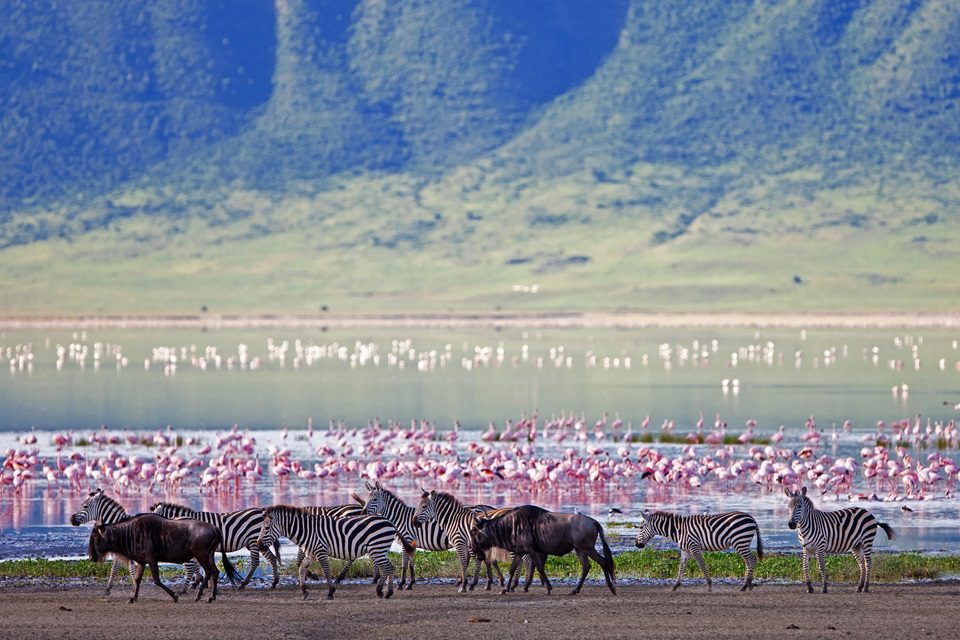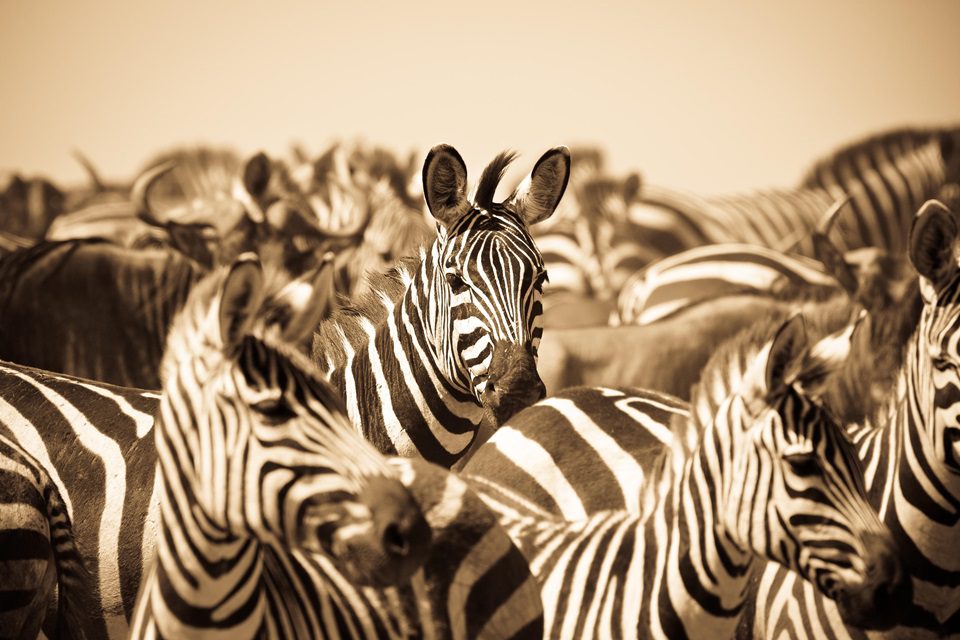

Welcome to the Ngorongoro Crater, often hailed as the “Eighth Wonder of the World” and a crown jewel of Tanzania safaris. Nestled in the heart of Tanzania’s Northern Circuit, this UNESCO World Heritage Site is a natural amphitheater teeming with wildlife, dramatic landscapes, and rich cultural heritage. If you’re searching for the best safari destinations in Africa, Ngorongoro Crater tours, or tips on the best time to visit Ngorongoro Crater, you’ve landed on the ultimate guide.
The Ngorongoro Crater is the world’s largest intact volcanic caldera, formed millions of years ago from a massive eruption. Spanning approximately 260 square kilometers (100 square miles) with walls rising up to 600 meters (2,000 feet) high, it’s a self-contained ecosystem often called “Africa’s Garden of Eden.” Located in the Ngorongoro Conservation Area in northern Tanzania, it’s part of the larger Serengeti ecosystem and borders the famous Serengeti National Park.
Why is it so special? Unlike typical national parks, the crater floor is a year-round haven for over 25,000 large animals, including the iconic Big Five (lion, leopard, elephant, buffalo, and rhinoceros). It’s a UNESCO World Heritage Site since 1979, recognized for its outstanding universal value in terms of natural beauty, biodiversity, and archaeological significance. Trending searches like Ngorongoro Crater facts often highlight its role as a “natural zoo” where predators and prey coexist in a confined space, making it one of the top wildlife viewing spots in Africa.
Semantically, the crater embodies concepts like volcanic landscapes in East Africa, biodiversity hotspots, and protected wildlife reserves. If you’re into adventure travel in Tanzania, this is where ancient geology meets modern conservation.
The Ngorongoro Crater is located in northern Tanzania. It borders the Serengeti to the west and Lake Manyara to the south. The city of Arusha, the main tourist hub of Tanzania, is approximately 190 km (118 mi) away, which is about a 4-hour drive by car.

Delving into the history of Ngorongoro Crater reveals a story of cataclysmic events. Around 2-3 million years ago, this was a super volcano taller than Mount Kilimanjaro, erupting violently and collapsing into the caldera we see today. Geological terms like caldera formation, rift valley systems, and volcanic ash deposits are key for semantic SEO, tying into broader searches for East African Rift Valley wonders.
Human history here is equally fascinating. The area has been inhabited by Maasai pastoralists for centuries, who coexist with wildlife under the Ngorongoro Conservation Area Authority (NCAA). Archaeological sites like Olduvai Gorge nearby (often searched as the cradle of mankind in Tanzania) have yielded fossils dating back 2 million years, including early hominid remains discovered by Louis and Mary Leakey.
In the 1950s, the area was designated a multiple land-use zone, balancing conservation with Maasai grazing rights, a model for sustainable wildlife management. Today, it’s a focal point for climate change impacts on African ecosystems, with studies on how rising temperatures affect water sources and animal migrations.
No Ngorongoro Crater safari is complete without marveling at its wildlife. The crater’s enclosed environment supports a staggering density of animals, making it ideal for game drives in Tanzania. Semantic clusters here include African savanna animals, predator-prey dynamics, and endangered species conservation.
The Big Five are all present: majestic lions (over 60 prides), elusive leopards in acacia trees, massive elephant herds, Cape buffalo in the thousands, and critically endangered black rhinos (around 30 individuals). Other stars include cheetahs, hyenas, wildebeest, zebras, giraffes, and over 500 bird species, from ostriches to colorful lovebirds.
For birdwatching enthusiasts searching best birding spots in Africa, Lake Magadi hosts flamingos, while forests shelter eagles and vultures. The crater’s biodiversity is a testament to Tanzania’s wildlife heritage, with seasonal migrations linking it to the Great Migration in Serengeti.
The best time to visit Ngorongoro Crater is from June to October during the dry season, when wildlife viewing is at its peak. Animals gather around water sources, making it easy to spot lions, elephants, rhinos, buffalo, and other iconic species. The skies are clear, the vegetation is thinner, and conditions are ideal for photography. However, this is also the busiest season, so expect more safari vehicles inside the crater.
Ngorongoro Crater is unique because it offers year-round game viewing. Even during the rainy season, wildlife remains inside the crater due to its permanent water and grazing grounds. This makes it one of the most reliable safari destinations in Africa.
From November to May, the crater transforms into a lush green paradise. This period, known as the green season, is quieter with fewer tourists. It is especially rewarding between December and March, when the wildebeest calving season takes place in the nearby Ndutu plains. Thousands of newborn calves attract predators, making it one of the most dramatic wildlife spectacles in Tanzania. Birdwatchers will also enjoy this time as migratory species arrive in large numbers.
The rainiest months are April and May, bringing heavier downpours that can make roads muddy, but the scenery is breathtaking, and lodges often offer reduced rates. For travelers seeking fewer crowds and lower prices, this is an attractive option.
In summary, if you want the best wildlife viewing conditions, plan your trip between June and October. If you prefer a quieter safari with green landscapes and birdlife, consider November to March. With permanent wildlife and stunning scenery, the Ngorongoro Crater is truly a year-round destination.
Ngorongoro Crater is in northern Tanzania, about 180 kilometers west of Arusha. It lies within the Ngorongoro Conservation Area, a UNESCO World Heritage Site that borders the Serengeti.
The crater was created around two to three million years ago when a massive volcano erupted and collapsed on itself. What remains is the world’s largest unbroken caldera, 20 kilometers wide and over 600 meters deep.
Ngorongoro is celebrated for its incredibly high concentration of wildlife in a relatively small area. Often called the “Garden of Eden,” it is home to more than 30,000 animals, including the Big Five, rare black rhinos, and spectacular birdlife.
Yes. Ngorongoro is one of the best places in Africa to see all members of the Big Five: lion, leopard, elephant, buffalo, and black rhino. The crater is especially renowned for its rhino population, which is rarely seen elsewhere.
Ngorongoro can be visited year-round. The dry season (June to October) offers excellent visibility and easier wildlife spotting. The wet season (November to May) transforms the crater into a lush, green paradise with fewer crowds and more dramatic scenery.
Most travelers spend one or two days exploring the crater itself. A single full-day safari is often enough to see an extraordinary variety of animals, but staying longer allows you to explore the highlands, Olduvai Gorge, and nearby Maasai villages.
Protected by Security by CleanTalk